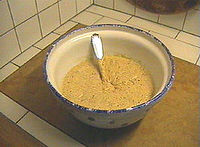- Fermentation starter
-
Fermentation starters (called simply starters within the corresponding context) are preparations to assist the beginning of the fermentation process in preparation of various foods and fermented drinks. A starter culture is a microbiological culture which actually performs fermentation. These starters usually consist of a cultivation medium, such as grains, seeds, or nutrient liquids that have been well colonized by the microorganisms used for the fermentation.
In descriptions of national cuisines, fermentation starters may be referred to by their national names:
- Qū (simplified: 曲; traditional: 麴, also romanized as chu) (China)
- Nuruk or Nulook < HS code: 2102.20.2000 > (누룩), meju or Mae-joo < HS code: 2103.90.9040 > or Mae-zu (메주) (Korea)
- Koji (麹) (Japan)
- Ragi (Southeast Asia)
- Bakhar, ranu, marchaar (murcha) (India)
- Bubod (Philippines)
- Loopang (look pang Thai: ลูกแป้ง) (Thailand)
- Levain (France)
- Bread zakvaska (закваска, sourdough) (Russia, Ukraine)
- Opara (опара), (Russia), a starter based on yeast
These starters are formed using a specific cultivation medium and a specific mix of fungal and bacterial strains.[1][2]
Typical microorganisms used in starters include various bacteria and fungi (yeasts and molds): Rhizopus, Aspergillus, Mucor, Amylomyces, Endomycopsis, Saccharomyces, Hansenula anomala, Lactobacillus, Acetobacter, etc. Various national cultures have various active ingredients in starters, and often involve mixed microflora.[1]
Industrial starters include various enzymes, in addition to microflora.[1]
See also
- Bread starter
- Leaven
- Malting
References
- ^ a b c Norman F. Haard, S.A. Odunfa, Cherl-Ho Lee, R. Quintero-Ramírez, Argelia Lorence-Quiñones, Carmen Wacher-Radarte, Fermented Cereals: A Global Perspective, Food and Agriculture Organization, Rome, 1999, ISBN 92-5-104296-9.
- ^ Dilip K. Arora, Libero Ajello, K. G. Mukerji, Handbook of Applied Mycology: Foods and Feeds, Volume 3, CRC Press, 1991, ISBN 082478491.
Categories:
Wikimedia Foundation. 2010.

